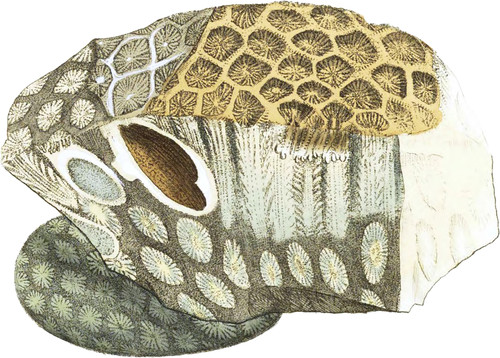 Enlarge
Enlarge
British Mineralogy
Coralliform Flint
- Div. 2. Imitative.
This is one of the most beautiful, and perhaps local, of the Flint Coral formations, and is found in tolerable abundance in a field near Tidsbury, Wiltshire, in pieces, sometimes as large as a quartern loaf. Some specimens show the remaining form of a real Coral most perfectly; having at the same time little globular infiltrations, as if in the act of filling the spaces of the Coral with a whitish cakedony or cachalong-like substance, which more solidly pervades the Flint in other parts; and again a considerable part of the petrifaction is in so solid a state, that it retains a great degree of semi transparency, and either the reticulated or stellated structure; or both remain distinguished by the whitish opaque Calcedony, so beautifully, that it is one of the most curious subjects that I know of for ornamental jewellery. I have most of the varieties here figured as one specimen, but not on the same piece. Besides the stony representation of a Coral, perhaps new to our catalogue, there often remains the oval hole of the Mytilus or Pholas, which are known to bore holes in old Corals and various rocks.
I am obliged to my good and very generous friends, Thomas Mead and William Cunnington, Esquires, for most of my specimens of this curious modification of Flint, and I have some specimens of Coral Limestone from the last-mentioned gentleman from Steeple Ashton, which have sufficient of the remains of the shell to discover by comparison that it agrees with Mytilus lithophagus of Linn. Trans. vol. 8, or the other new species, which I am inclined to think the cross-beaked one is, although the beaks are only a sort of accumulated appendage. I think it ought to be distinguished by some title different from the usual one, and might therefore be called Mytilus curvirostris. The signs of these, and innumerable remains of organization, seem to be the cause of the various spots in all common Flints, although they are often loo much obliterated to show it, as it happens in some parts of the above specimens.
The Flint appears to have first entered into the substance of the Coral, and then seems to have been filling up the spaces between the ramifications, and is in some places to be detected in the operation; but some Flints have the general shape of a Coral, but not the least resemblance in other particulars. I have such as show what they are by the internal structure, from different parts of Wiltshire.

